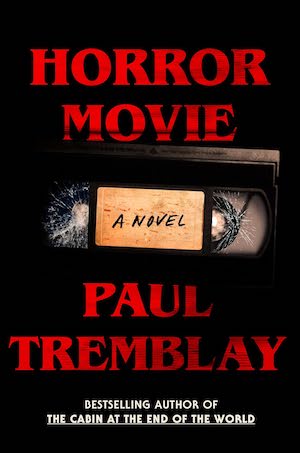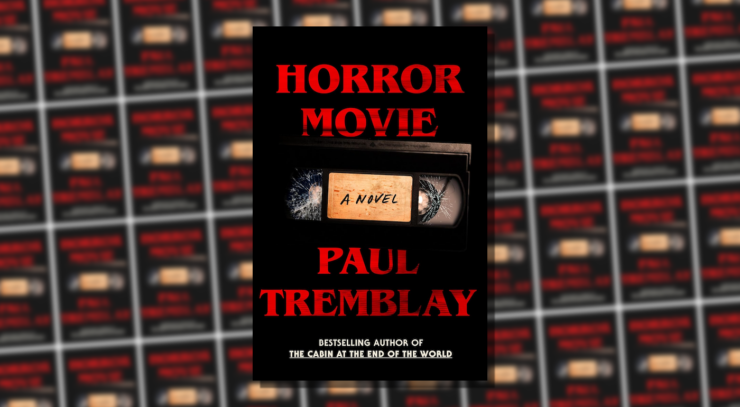Paul Tremblay’s new novel Horror Movie got me thinking about the writings of Peter Straub. There’s a very good reason for this: The novel is dedicated in part to his memory, and one of the characters in Horror Movie references Straub’s novel Koko. Those aren’t the only reasons that I’m thinking of the two writers in dialogue with one another.
One of the things I’ve long admired about Straub is the way that his work evolved and grew stranger over the course of his career. Some writers find their niche and stay there; Straub took big risks that, more often than not, paid off. (Learning that Straub was a jazz fan made a lot of things click into place for me.) Reading Paul Tremblay’s Horror Movie, I’m wondering if Tremblay has taken this same approach.
Between 2015 and 2020, four of Tremblay’s novels were published to great acclaim: A Head Full of Ghosts, Disappearance at Devil’s Rock, The Cabin at the End of the World, and Survivor Song. It’s a hell of a run. (It also neatly corresponds with Straub’s work published between 1979 and 1984: Ghost Story, Floating Dragon, Shadowland, and The Talisman—the last of those a collaboration with Stephen King.) And it would have been very easy for Tremblay to continue in that vein indefinitely, returning to themes of possession, belief, and the end of the world from different angles.
That isn’t what he’s done, however. The centerpiece of Tremblay’s 2023 collection The Beast You Are is a novella told in verse set in a world populated by anthropomorphic animals. 2022’s The Pallbearers Club is told via the form of an annotated manuscript. “Some of Tremblay’s work has been rumored to be headed to the silver screen, including the aforementioned The Cabin at the End of the World,” I wrote in my review of the novel. “What’s most interesting about this novel, then, is how it feels at times like a reaction to that. It’s difficult to imagine this being adapted into any other medium and working nearly as well.”
Buy the Book


Horror Movie
And now we have Horror Movie, which is—we’ll eventually learn—presented as two found documents. One is the screenplay (or parts of the screenplay) for a 1993 indie horror movie called—wait for it—Horror Movie. The other is the memoir of an unnamed actor who played the role of The Thin Kid in the original and is also involved in the production of a remake/reboot in the present day. That remake-versus-reboot distinction is worth bringing up here, because it turns out that the 1993 film was never shown; instead, only a handful of clips have surfaced. Eventually we’ll learn that the actor’s memoir is, in fact, an audiobook, adding more ambiguity around the circumstances under which he’s recounting his memories.
In 1993, the narrator was part of the cast of an independent horror film directed by Valentina, a woman he’d met while both were in college—though not, he notes, the same one—and written by Valentina’s friend Cleo. Precisely what the film is about takes a little while to tease out; it begins with three high school students taking a fourth—the aforementioned Thin Kid—to an abandoned school, putting a monster mask on his head, and engaging in a series of bizarre and ritualistic acts. That the actors (including Valentina and Cleo) play characters who share their names is one aspect of the novel that blurs the line between reel and real. Tremblay gives us plenty of the screenplay in the book, but it’s worth noting that this screenplay is very much presented as a found document, with a number of asides from Cleo in the descriptions of several scenes. There are certain details in there that, short of Malickian levels of voice-over narration, would not translate easily to film.
[Cleo] wants to say something again. She wants to tell the Thin Kid about a line in Peter Straub’s novel KOKO, in which the killer thinks that demons are made to love and be loved.
Those glimpses of the 1993 production—both the screenplay and the narrator’s own memories—are interwoven with scenes set in the present day. Here, the narrator meets with people interested in the production, including director Marlee Bouton, an acclaimed indie filmmaker with a penchant for horror. It’s in these scenes that Tremblay foreshadows several very bad things awaiting the cast and crew of the 1993 film. “Of course you already know about Cleo,” the narrator says at one point—but of course we don’t, not yet, but that sure is telling us something bad is lurking just a few pages away.
The original version of Horror Movie was never completed. It’s a fictional cult movie whose cult has developed around a handful of artifacts—relics, let’s say—that trickled out from its troubled production. It’s one of a few ways in which ritual acts are embedded in both the overall narrative of this novel and of the narratives that are nestled within it.
While the two novels are tonally very different, Horror Movie shares with The Pallbearers Club a fondness for narrative ambiguity; in both cases, how reliable you find the narrator will play a significant part in what your takeaway from the novel is. There’s an interpretation of Horror Movie in which the horrors told in its pages stem entirely from people’s mistreatment of one another. There’s also a reading of it in which something much stranger is happening. In the end, the outcomes are every bit as chilling whether or not a demonic presence is afoot.
The narrator here may or may not be reliable, but he’s also not the only potentially unreliable narrator present. At one point, the screenplay again, nominally from a film from 1993—alludes to a song that wouldn’t be released for another two years. I filed that away as artistic license right up until the point that the narrator brought it up, in the context of whether or not the screenplay we’re reading is the same one that was used to make the first version of Horror Movie.
Horror Movie could have easily collapsed in on itself. That it doesn’t speaks to the intricacy of its structure and the memorable voice of its narrator, a figure at once trickster and trauma victim, with a compelling blend of everyman demeanor and something fundamentally unknown. It also doesn’t hurt that Horror Movie—the movie—feels compelling in its own right: a kind of blend of The Cabinet of Dr. Caligari, The Blair Witch Project, and Lake Mungo. Tremblay’s novel borrows a cinematic grammar, but its goals are supremely literary—to chilling effect.
Horror Movie is published by William Morrow.










